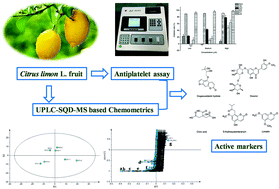当前位置:
X-MOL 学术
›
Food Funct.
›
论文详情
Our official English website, www.x-mol.net, welcomes your
feedback! (Note: you will need to create a separate account there.)
Characterization of active antiplatelet chemical compositions of edible Citrus limon through ultra-performance liquid chromatography single quadrupole mass spectrometry-based chemometrics†
Food & Function ( IF 5.1 ) Pub Date : 2018-04-04 00:00:00 , DOI: 10.1039/c8fo00403j Qian Zhang 1, 2, 3, 4 , Chengning Tan 1, 2, 3, 4 , Liang Cai 1, 2, 3, 4 , Fangbo Xia 4, 5, 6, 7, 8 , Die Gao 4, 9, 10, 11 , Fengqing Yang 1, 2, 3, 4 , Hua Chen 1, 2, 3, 4 , Zhining Xia 1, 2, 3, 4
Food & Function ( IF 5.1 ) Pub Date : 2018-04-04 00:00:00 , DOI: 10.1039/c8fo00403j Qian Zhang 1, 2, 3, 4 , Chengning Tan 1, 2, 3, 4 , Liang Cai 1, 2, 3, 4 , Fangbo Xia 4, 5, 6, 7, 8 , Die Gao 4, 9, 10, 11 , Fengqing Yang 1, 2, 3, 4 , Hua Chen 1, 2, 3, 4 , Zhining Xia 1, 2, 3, 4
Affiliation

|
Citrus limon L. (lemon, family: Rutaceae) is the third most popular edible fruit among the Citrus species. Our previous study has shown the significant antiplatelet activity of lemon extracts. The aim of the present study is to identify the features (retention time, m/z) associated with the antiplatelet activity of lemons by correlating a platelet aggregation assay with ultra-performance liquid chromatography single quadrupole mass spectrometry-based chemometrics analysis. The primary bioactivity-guided test results revealed that the butanol (BA) and ethyl acetate (EA) liquid–liquid extraction sections of the ethanol extract of lemons had significant inhibitory effects on platelet aggregation. Upon further separating the combined BA and EA sections with a silica column, four different active fractions were obtained, and their LC-MS data were collected. After modeling by two multivariate statistical techniques, namely, principal component analysis and orthogonal partial least squares discriminate analysis seven markers were predicted, identified, and tentatively classified as priority markers of bioactivity in lemons. Among them, the antiplatelet activity of four marker compounds, namely, oxypeucedanin hydrate, citric acid, diosmin, and limetin at concentrations lower than 300 μM was confirmed. Moreover, the specific mechanism of limetin interaction with the TP β receptor of thromboxane A2 and the effect of limetin on the PI3 K/Rap-1b signaling pathway through the βγ subunit of GPCR (i) in platelet aggregation were studied by differential proteomic analysis to illustrate the validity and persistence of these markers for application in lemon fruit platforms.
中文翻译:

通过超高效液相色谱法,基于单四极杆质谱的化学计量学 对食用柑橘柠檬的活性抗血小板化学成分进行表征†
柑桔柠檬(柠檬,家族:芸香科)是柑桔物种中第三大最受欢迎的可食用水果。我们先前的研究表明柠檬提取物具有显着的抗血小板活性。本研究的目的是确定特征(保留时间,m / z)将血小板聚集测定与超高效液相色谱-基于单四极杆质谱的化学计量分析相关联,从而与柠檬的抗血小板活性相关)。初步的生物活性指导试验结果表明,柠檬乙醇提取物的丁醇(BA)和乙酸乙酯(EA)液液提取部分对血小板聚集具有明显的抑制作用。用硅胶柱进一步分离合并的BA和EA部分后,获得了四个不同的活性馏分,并收集了它们的LC-MS数据。通过两种多元统计技术进行建模后,即主成分分析和正交偏最小二乘判别分析,可以预测,识别出七个标记,并暂时归类为柠檬中生物活性的优先标记。在其中,证实了四种标记物化合物,即水合氧哌丁宁,柠檬酸,薯os皂素和石灰质的抗血小板活性,其浓度低于300μM。此外,通过差异蛋白质组分析,研究了钙蛋白与血栓烷A2的TPβ受体相互作用的具体机理,以及钙蛋白通过GPCR(i)中的GPCR的βγ亚基对PI3 K / Rap-1b信号通路的影响。说明了这些标记在柠檬水果平台上应用的有效性和持久性。
更新日期:2018-04-04
中文翻译:

通过超高效液相色谱法,基于单四极杆质谱的化学计量学 对食用柑橘柠檬的活性抗血小板化学成分进行表征†
柑桔柠檬(柠檬,家族:芸香科)是柑桔物种中第三大最受欢迎的可食用水果。我们先前的研究表明柠檬提取物具有显着的抗血小板活性。本研究的目的是确定特征(保留时间,m / z)将血小板聚集测定与超高效液相色谱-基于单四极杆质谱的化学计量分析相关联,从而与柠檬的抗血小板活性相关)。初步的生物活性指导试验结果表明,柠檬乙醇提取物的丁醇(BA)和乙酸乙酯(EA)液液提取部分对血小板聚集具有明显的抑制作用。用硅胶柱进一步分离合并的BA和EA部分后,获得了四个不同的活性馏分,并收集了它们的LC-MS数据。通过两种多元统计技术进行建模后,即主成分分析和正交偏最小二乘判别分析,可以预测,识别出七个标记,并暂时归类为柠檬中生物活性的优先标记。在其中,证实了四种标记物化合物,即水合氧哌丁宁,柠檬酸,薯os皂素和石灰质的抗血小板活性,其浓度低于300μM。此外,通过差异蛋白质组分析,研究了钙蛋白与血栓烷A2的TPβ受体相互作用的具体机理,以及钙蛋白通过GPCR(i)中的GPCR的βγ亚基对PI3 K / Rap-1b信号通路的影响。说明了这些标记在柠檬水果平台上应用的有效性和持久性。











































 京公网安备 11010802027423号
京公网安备 11010802027423号